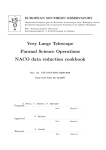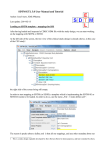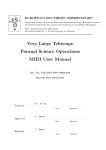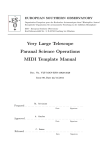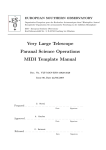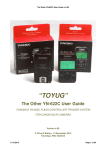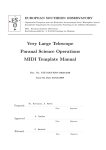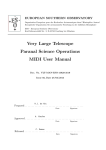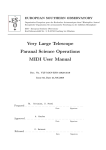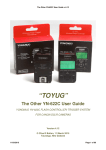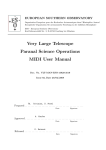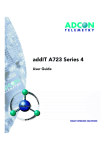Download MIDI data reduction cookbook
Transcript
EUROPEAN SOUTHERN OBSERVATORY Organisation Européene pour des Recherches Astronomiques dans l’Hémisphère Austral Europäische Organisation für astronomische Forschung in der südlichen Hemisphäre ESO - European Southern Observatory Karl-Schwarzschild Str. 2, D-85748 Garching bei München Very Large Telescope Paranal Science Operations MIDI data reduction cookbook Doc. No. VLT-MAN-ESO-15820-4039 Issue 87.0, Date 23/03/2011 C. Hummel, S. Morel, T. Rivinius Prepared . . . . . . . . . . . . . . . . . . . . . . . . . . . . . . . . . . . . . . . . . . Date Approved A. Kaufer . . . . . . . . . . . . . . . . . . . . . . . . . . . . . . . . . . . . . . . . . . Date Released Signature Signature C. Dumas . . . . . . . . . . . . . . . . . . . . . . . . . . . . . . . . . . . . . . . . . . Date Signature MIDI data reduction cookbook VLT-MAN-ESO-15820-4039 This page was intentionally left blank ii MIDI data reduction cookbook VLT-MAN-ESO-15820-4039 iii Change Record Issue/Rev. Date Section/Parag. affected Reason/Initiation/Documents/Remarks 87.0 23/03/201 81.0 29/08/2007 all Period update 78.0 30/11/2006 all creation — Edition for approval MIDI data reduction cookbook VLT-MAN-ESO-15820-4039 This page was intentionally left blank iv MIDI data reduction cookbook VLT-MAN-ESO-15820-4039 v Contents 1 Preamble 1.1 Purpose . . . . . . . . . . . 1.2 Reference documents . . . . 1.3 Abbreviations and acronyms 1.4 Stylistic conventions . . . . 1.5 Where to find help and learn . . . . . 1 1 1 1 2 2 . . . . 3 3 3 3 4 . . . . . . . . . . . 5 5 5 6 6 6 7 7 7 7 7 8 4 The MIDI Pipeline 4.1 Purpose . . . . . . . . . . . . . . . . . . . . . . . . . . . . . . . . . . . . . . . 4.1.1 Downloading and installing . . . . . . . . . . . . . . . . . . . . . . . . 9 9 9 . . . . . . . . . . . . . . . . . . . . . . . . . . . . . . . . . . . . . . . . . . . . . . . . about interferometry 2 Introduction 2.1 A few words about interferometry 2.2 The interferometric signal . . . . 2.3 Observing procedures . . . . . . . 2.4 Photometric normalizations . . . 3 MIDI FITS Information 3.1 MIDI file structure . . . . . . . 3.2 Extracting FITS Information . 3.3 Visualizing FITS Tables . . . . 3.4 File Names . . . . . . . . . . . 3.5 Telescope Keywords . . . . . . 3.6 Instrument Keywords . . . . . 3.7 Observation Block Keywords . 3.8 Template Keywords . . . . . . 3.8.1 Keywords common to all 3.9 Quality Control Products . . . 3.10 Summary Table . . . . . . . . . 5 MIDI interactive 5.1 MIA . . . . . 5.2 EWS . . . . . 5.3 MyMidiGui . . . . . . . . . . . in the mid-infrared . . . . . . . . . . . . . . . . . . . . . . . . . . . . . . . . . . . . . . . . . . . . . . . . . . . . . . . . . . . . . . . . . . . . . . . . . . . . . . . . . templates . . . . . . . . . . . . . . . . . . . . . . . . . . . . . . . . . . . . . . . . . . . . . . . . . . . . . . . . . . . . . . . . . . . . . . . . . . . . . . . . . . . . . . . . . . . . . . . . . . . . . . . . . . . . . . . . . . . . . . . . . . . . . . . . . . . . . . . . . . . . . . . . . . . . . . . . . . . . . . . . . . . . . . . . . . . . . . . . . . . . . . . . . . . . . . . . . . . . . . . . . . . . . . . . . . . . . . . . . . . . . . . . . . . . . . . . . . . . . . . . . . . . . . . . . . . . . . . . . . . . . . . . . . . . . . . . . . . . . . . . . . . . . . . . . . . . . . . . . . . . . . . . . . . . . . . . . . . . . . . . . . . . . . . . . . . . . . . . . . reduction . . . . . . . . . . . . . . . . . . . . . . . . . . . . . . . . . . . . . . . . . . . . . . . . . . . . . . . . . . . . . . . . . . . . . . . . . . . . . . . . . . . . . . . . . . . . . . . . . . . . . . . . . . . . 10 10 11 11 6 Issues to pay attention to 12 7 A few words on MIDI data analysis 13 MIDI data reduction cookbook 1 1.1 VLT-MAN-ESO-15820-4039 1 Preamble Purpose This document is intended to get astronomers started on the reduction of their MIDI data, describing the various formats delivered by MIDI and the software available. Observational procedures are also discussed. This document does not describe the MIDI instrument, its modes of operations, how to acquire data, the offered templates, or the various issues attached to Phase II Proposal Preparation. The reader is assumed to have read the MIDI User’s Manual beforehand, and have a basic knowledge of interferometric and mid-infrared data reduction. Furthermore, this document makes extensive use of references to on-line material and resources. At the time of writing, MIDI data reduction is still in a state of rapid evolution, especially with respect to the fine-tuning of parameters for the data obtained with the ATs. Therefore, as the external sources are more easily kept up to date, the purpose of this document shall be restricted strictly to providing guidance to the users, as well as useful references. 1.2 1 2 3 1.3 Reference documents MIDI User Manual (http://www.eso.org/instruments/midi/doc/) MIDI Calibration Plan (http://www.eso.org/instruments/midi/doc/) ESO DICB - Data Interface Control Document - GEN-SPE-ESO-00000-0794 (http://archive.eso.org/DICB/) Abbreviations and acronyms The following abbreviations and acronyms are used in this document: AT Auxilliary Telescope ESO European Southern Observatory Dec Declination DICB Data Interface Control Board DIT Detector Integration Time DPR Data Products (FITS identifier) EWS Expert Workbench Station FITS Flexible Image Transport System GUI Graphical User Interface IDL Interactive Data Language (ITT Ind. Inc.) IO Input output MACAO Multi Application Curvature Adaptive Optics MIA MIDI Interactive Analysis MIDI Mid-Infrared Instrument PAF PArameter File RA Right Ascension SciOps Science Operations UT Unit Telecope VLT Very Large Telescope VLTI Very Large Telescope Interferometer MIDI data reduction cookbook 1.4 VLT-MAN-ESO-15820-4039 2 Stylistic conventions The following styles are used: bold in the text, for commands, etc., as they have to be typed. italic for parts that have to be substituted with real content. box for buttons to click on. teletype for examples and filenames with path in the text. Bold and italic are also used to highlight words. 1.5 Where to find help and learn about interferometry • VLTI: http://www.eso.org/projects/vlti/ • Optical Long Baseline Interferometry News (OLBIN): http://olbin.jpl.nasa.gov/index.html • MIDI data reduction: http://www.sc.eso.org/ chummel/midi/midi.html • MIA+EWS: http://www.strw.leidenuniv.nl/ nevec/MIDI/index.html • Jean-Marie Mariotti Center (JMMC): http://www.mariotti.fr/ MIDI data reduction cookbook 2 2.1 VLT-MAN-ESO-15820-4039 3 Introduction A few words about interferometry in the mid-infrared The mid-infrared can be seen both as a regime of the optical and radio techniques. Heterodyne technology, applied in the radio, has been used to build an interferometer working at 10 microns (http://isi.ssl.berkeley.edu/). The main characteristic of this regime is the high background against which the object flux has to be extracted. A radio interferometer uses the fact that the background is uncorrelated and therefore drops out during the correlation process. In MIDI, the two outputs of the beam combiner are subtracted from each other, removing the background fluctuations while preserving the interference fringes due to their 180 degree phase difference between the outputs. The photometry necessary to normalize the correlated flux is obtained by using standard chopping techniques, which provide the differential measure between target and background. Nodding is not applied with MIDI. 2.2 The interferometric signal To derive the interferometric signal, i.e. the intensity of the combined light as a function of optical path length difference between the two beams (OPD), assume two fully coherent (γ = 1) monochromatic (wavelength λ) beams A and B of light with electrical field amplitudes of AA and AB . If interfered, their electric field vectors will add, and the total amplitude will vary, as a function of OPD, between AA + AB and AA − AB . Since intensity of light is the square of the electric field vectors integrated over a time interval, it will vary between I max = A2A + 2AA AB + A2B and I min = A2A − 2AA AB + A2B . Therefore, using the definition of the visibility amplitude as V = (I max − I min )/(I max + I min ), √ the maximum visibility of two interfering beams of intensities IA and IB will be V max = 2 IA IB /(IA + IB ). This visibility will of course be less if the beams are only partially coherent (γ < 1), and the bandwidth of the light is wide. From now on we write V = γV max . The intensity of light in the two interferometric channels of MIDI can be written as (here for I1 only) I1 = IA,1 + IB,1 + (1/2)(I1max − I1min )V sin(2πOP D/λ) q where (1/2)(I1max − I1max ), the intensity variation due to interference, is equal to 2 IA,1 IB,1 . Due to the beam splitter, IA,1 = κ1,A IA , and so forth, defining the coefficients of the so-called κ-matrix. An interferogram, i.e. the intensity as a function of OPD of a single scan across the fringe packet free from background variations, is derived as mentioned above by computing I1 − I2 . The background will be greatly reduced to IA (κ1,A − κ2,A + α(κ1,B − κ2,B )) where α is the ratio of the beam from the two telescopes. The fringe signals, however, will add, q intensities q to become 2V IA,1 IB,1 + 2V IA,1 IB,1 . 2.3 Observing procedures The variability of the background with time and airmass makes it desirable to measure all necessary quantities for the visibility determination simultaneously. These include the instantaneous total and correlated flux. For this purpose, the SCI PHOT beam combiner extracts from the two input beams the photometry channels (30% extraction), and the remainder is MIDI data reduction cookbook VLT-MAN-ESO-15820-4039 4 interfered to produce two channels with the interferometric signal. If the target is faint, the HIGH SENS combiner directs all light into the interferometric channels, requiring the photometry to be done following the fringe exposure. The telescopes are chopping during the photometry in HIGH SENS mode, and during the combined fringe and photometry exposures in SCI PHOT mode. They are not chopping during the fringe exposure in HIGH SENS mode. 2.4 Photometric normalizations To compute the normalization in the HIGH SENS mode, two photometric exposures are done, one with shutter A open, the other with shutter B. The resulting spectra IAB,12 can be used q q directly to compute the normalization factor IA,1 IB,1 + IA,2 IB,2 , by which the correlated flux, computed from the interferogram I1 − I2 has to be divided. In SCI PHOT mode, the same photometric exposures, this time on any bright target, are used to compute the coefficients of the κ-matrix, as follows: κ1,A = I1 /(I1 + I2 ), κ2,A = I2 /(I1 + I2 ), and so forth. (Therefore, it does not matter whether the photometry exposures are done using the HIGH SENS or SCI PHOT beam combiners.) The κ-matrix coefficients can then be used to compute the IAB,12 from the spectra PA,B determined from the photometric channels. MIDI data reduction cookbook 3 VLT-MAN-ESO-15820-4039 5 MIDI FITS Information 3.1 MIDI file structure A MIDI data set consists of a fringe exposure and of two photometry exposures (beam-A-only and beam-B-only) in HIGH SENS mode. There is normally one file per exposure, but the files are limited to 100 MB. If the amount of data in an exposure is bigger than this limit, it is split into two or more files, each one not bigger than 100 MB. Each file is in FITS format and contains several HDUs (header-data units) that can be visualized using fv (see Sect. 3.3). The structure of a MIDI file is the following: • HDU1: Primary FITS header containing information about the observation. • HDU2: Header + table of instrument setup description. • HDU3: Header + table of instrument train. • HDU4: Header + table containing the frame data (each line contains for each frame the matrices of pixel values in the detector windows, and the information about the frame like time, local OPD). • HDU5: Header + table giving for each frame the local OPL. Ancillary data attached to MIDI files are all written into FITS headers. This chapter lists the most important keywords and describes commands on how to retrieve them. For ease of reading, keywords are shortened from HIERARCH ESO A B C to A.B.C (shortFITS notation). Note that all of this information is present in the ESO dictionaries, available from the ESO archive Web site (http://archive.eso.org/DICB/). This chapter only tries to summarize the most important information. 3.2 Extracting FITS Information There are many tools to extract and parse FITS headers. One convenient way of extracting FITS information and displaying it on a terminal or re-directing it to a text file, is to use two stand-alone programs called dfits and fitsort. Both are included into the eclipse distribution (http://www.eso.org/eclipse). dfits dumps a FITS header on stdout. You can use it to dump the FITS headers of many files, to allow the parsing of the output. Example: dfits *.fits | grep "TPL ID" Usually, you want to get the value of a list of given FITS keywords in a list of FITS files. fitsort reads the output from dfits, classifies the keywords into columns, and prints out in a readable format the keyword values and file names. Example: dfits *.fits | fitsort NAXIS1 NAXIS2 BITPIX fitsort also understands the shortFITS notation, where e.g. HIERARCH ESO TPL ID is shortened to TPL.ID. A classification example could be (both commands are equivalent, since fitsort is case-insensitive): dfits *.fits | fitsort TPL.ID DPR.TYPE MIDI data reduction cookbook VLT-MAN-ESO-15820-4039 6 dfits *.fits | fitsort tpl.id dpr.type The output from this combination is something like: FILE TPL.ID MIDI.2006-09-27T02:13:43.000.fits MIDI starintf MIDI.2006-09-27T02:14:57.506.fits MIDI starintf MIDI.2006-09-27T02:16:12.013.fits MIDI starintf MIDI.2006-09-27T02:18:23.000.fits MIDI starintf MIDI.2006-09-27T02:19:37.485.fits MIDI starintf MIDI.2006-09-27T02:21:27.000.fits MIDI starintf MIDI.2006-09-27T02:22:41.506.fits MIDI starintf obs obs obs obs obs obs obs fringe fringe fringe fringe fringe fringe fringe DPR.TYPE TRACK,OBJECT,DISPERSED TRACK,OBJECT,DISPERSED TRACK,OBJECT,DISPERSED PHOTOMETRY,OBJECT PHOTOMETRY,OBJECT PHOTOMETRY,OBJECT PHOTOMETRY,OBJECT This kind of table is useful in getting an idea of what is present in a directory or list of directories. Loading such a summary table into a spreadsheet program also makes it conveniently readable. In this example, we see files related to an observation with MIDI in HIGH SENS mode, including fringe exposure and two photometry exposures, one for shutter A and one for shutter B. MIDI detector files are cut into more manageable sub-files of about 100 MByte in size. Therefore, in the above example, just three exposures are present. 3.3 Visualizing FITS Tables Similarly, a FITS table can be visualized on the command-line using the dtfits command. Alternatively, we recommend using fv, available from http://heasarc.gsfc.nasa.gov/docs/software/ftools/fv/. dfits and fitsort will help you classify tables and see ancillary data attached to them, but dtfits will display all information contained in the table itself, in ASCII format on the commandline. There are various options to help make the output readable on a terminal, or by a spreadsheet program. See the dtfits manual page to get more information. 3.4 File Names ORIGFILE contains the name of the file on the instrument workstation. ARCFILE is the archive file name. 3.5 Telescope Keywords Here is a non-exhaustive list of telescope keywords. RA Right ascension (J2000) in degrees. Notice that the comment field indicates the value in hh:mm:ss.s format. DEC Declination (J2000) in degrees. Notice that the comment field indicates the value in hh:mm:ss.s format. ADA.POSANG Position angle on sky as measured from North to East.(degrees). TEL.AIRM.START Airmass at start. TEL.AIRM.END Airmass at end. TEL.AMBI.FWHM.START Astronomical Site Monitor seeing at start. Note that this value might differ significantly from the MIDI image quality, which is usually better. TEL.AMBI.FWHM.END Astronomical Site Monitor seeing at start. Note that this value might MIDI data reduction cookbook VLT-MAN-ESO-15820-4039 7 differ significantly from the MIDI image quality, which is usually better 3.6 Instrument Keywords Here is a non-exhaustive slit of instrument keywords. INS.GRIS GRISM or PRISM. INS.OPTI1 Beam combiner, SCI PHOT or HIGH SENS. INS.SHUT Shutter, AOPEN or BOPEN. INS.FILT.NAME Acquisition filter. 3.7 Observation Block Keywords OBS.PROG.ID Program ID. OBS.NAME Name of the OB (as prepared with P2PP). OBS.TARG.NAME Target package name (as prepared with P2PP). 3.8 3.8.1 Template Keywords Keywords common to all templates TPL.ID contains an unique identifier describing the template which was used to produce the data. Frame selection in the pipeline is mostly based on this keyword value. DPR.CATG Data Product category (SCIENCE, CALIB, ...). DPR.TYPE Data Product type (OBJECT, SKY, ...). DPR.TECH Data Product acquisition technique (e.g. IMAGE, SPECTRUM). TPL.NEXP Number of scheduled exposures within the template. 3.1 TPL.EXPNO Exposure number within template. A template may produce several different frame types. Frames are discriminated by the value of the DPR keywords: DPR.CATG, DPR.TYPE, and DPR.TECH take different values depending on the observed frame type. 3.9 Quality Control Products Quality control outputs are produced into PAF files. A PAF file is a PArameter File containing formatted ASCII data looking like a FITS header. They are made so that human beings can read them easily, and so that they can also be parsed by software means. Keywords belonging to the realm of quality control products are currently being defined in a dictionary for later acceptance by the DICB board at ESO. Expect changes in the months following the release of this document. See the chapter dedicated to MIDI pipeline products for a full description of all possible output keywords. MIDI data reduction cookbook 3.10 VLT-MAN-ESO-15820-4039 Summary Table FITS keyword Meaning ARCFILE DEC DET.DIT DET.NDIT DPR.CATG DPR.TYPE DPR.TECH INS.GRIS INS.OPTI1 INS.SHUT INS.FILT.NAME Archive file name Declination (J2000) in degrees Detector Integration Time Number of (averaged) DITs Data product category Data product type Data product acquisition technique GRISM or PRISM. Beam combiner, SCI PHOT or HIGH SENS. Shutter, AOPEN or BOPEN. Acquisition filter. 8 MIDI data reduction cookbook 4 4.1 VLT-MAN-ESO-15820-4039 9 The MIDI Pipeline Purpose Pipelines can serve two purposes: First, to allow a quick and automatic reduction of data as it comes from the instrument, in order to make an assessment of the data quality. Second: a science-grade pipeline produces optimally calibrated products which can be analyzed scientifically without any further manipulation. The MIDI pipeline is of the first type, i.e. final data reduction for scientific analysis will be done using other reduction packages, which will be described in the following. 4.1.1 Downloading and installing The MIDI pipeline is not currently available for download. For up-to-date information, please check http://www.eso.org/projects/dfs/dfs-shared/web/vlt/vlt-instrument-pipelines.html. MIDI data reduction cookbook 5 VLT-MAN-ESO-15820-4039 10 MIDI interactive reduction Software packages have been written which provide a lot more parameters to optimize the reduction. The methods used fall into two distinct categories, coherent and incoherent analysis. The former method aims to improve the signal to noise ratio of the visibility amplitudes by implementing an off-line fringe tracking algorithm in order to align the interferograms before co-adding them. A differential visibility phase can be obtained too using this method. In the incoherent method, the power spectral density function of each scan across the interferogram is integrated to produce the squared visibility amplitude, which is then integrated over time. The package doing the coherent analysis is EWS (Expert Work Station) written by W. Jaffe (University of Leiden). The other incoherent packages are MIA (MIDI Interactive Analysis) written by R. Köhler et al. (Universities of Leiden and Heidelberg), and the Meudon Package, distributed by the JMMC (http://www.mariotti.fr/data processing midi.htm). MIA and EWS are distributed in a single installation available at: http://www.strw.leidenuniv.nl/∼nevec/MIDI/index.html. 5.1 MIA This software is based on IDL (ITT Industries Inc. http://www.ittvis.com/index.asp), also making use of a library of functions written in C. The C code is common to EWS and is used for IO and CPU intensive tasks such as computing the chopped frames. IDL provides the other computational services as well as a graphical user interface. A pecularity of the MIA implementation is object oriented approach, such that the results of the reduction are encoded in an IDL object, containing both data and methods. Since a good description of the use of MIA (and EWS) written by O. Chesneau is available at http://vltischool.obs.ujf-grenoble.fr/, we will just give a quick recipe for reducing a visibility spectrum. After installing MIA (currently in MIA+EWS-1.5), start and compile its code by typing mia.sh. Type f=midigui() and select, by clicking in the left most column, a file of kind: OBS FRINGE TRACK DISPERSED as well as two photometry files of type DEFAULT CHOP immediately following the fringe exposure. The click Select . Type: x=xmdv(f,/dwim) and MIA will reduce the selected files. Once ready, type: x->visibility() and you will get a listing of the visibility amplitudes. (The first column is the wavelength in microns, the second the wavelength bin, the third the visibility amplitude, and the fourth the photometric flux used for normalization.) If the same is done for a calibrator, dividing the target amplitudes by the calibrator amplitudes will calibrate the visibility spectrum, provided the calibrator is unresolved for the baseline used. Otherwise, a correction factor has to be applied. To see the methods associated with the object x, type: help,x,/obj To find out more, one has to look at the source code in MIA/xmidispvisi.pro. MIDI data reduction cookbook 5.2 VLT-MAN-ESO-15820-4039 11 EWS EWS routines can be used from within the same IDL session as MIA. However, EWS saves all relevant intermediate results on disk as FITS files. To run the EWS pipeline, select the files as before (f=midigui()), define a string variable to be used as a prefix for all filenames with intermediate results (e.g., tagsci=’HD8660’), and type: midipipe,tagsci,file=f Do the same for a calibrator (e.g., tagcal=’HD4128’), and then calibrate the science target using midicalibrate,tagsci,tagcal. Look for PostScript plot files in the working directory summarizing the results. To read the FITS file containing the reduced visibility amplitudes, use: v=oirgetvis(tagsci+’redcal.fits’). You can also read FITS files and binary extension tables using mrdfits, which is part of the IDLASTRO distribution (http://idlastro.gsfc.nasa.gov/). 5.3 MyMidiGui This IDL based GUI front-end for the MIA+EWS software was originally written for Paranal Science Operations by C. Hummel to support an alternative to the MIDI ESO-pipeline for the quick-look data quality assessment. It has since been integrated into the OYSTER interferometry analysis software: (http://www.sc.eso.org/∼chummel/oyster/oyster.html) which provides astrometry, modelling, and plotting capabilities. MyMidiGui can be found at: http://www.sc.eso.org/∼chummel/midi/mymidigui/mymidigui.html (including HTML documentation). MIDI data reduction cookbook 6 VLT-MAN-ESO-15820-4039 12 Issues to pay attention to Interferometry has always been a technique subject to many systematic errors, and MIDI is no exception. Especially the photometric calibration can be tricky, due to the high and variable background. The reader should pay attention to the following issues. • Masks and beam overlap: The spectra are extracted using a mask which excludes regions on the detector containing, most importantly, emission from outside the field of view, such as tunnel emmission. If the science target is too faint to be used to define the mask location, the calibrator can be used for this purpose. It is important to know that the perfect beam overlap is not guaranteed, even though during the acquisition, strict criteria are applied. Drifts can happen, and can in principle be monitored and corrected for with the SCI PHOT mode. Only the overlapping regions of the beams can contribute to the correlated flux, and therefore, the normalizing flux is computed by multiplying the chopped photometric frames corresponding to the two telescope beams first, before masking the frames and integrating the flux to obtain the spectra. • Sky background: MIA+EWS photometric routines estimate a baseline for the spectrum extraction by looking at the background in two windows on either side of the signal from the target. Despite the chopping, small residual baseline offsets may remain, which can be corrected for in this way. However, the field of view of the ATs is much smaller than the one of the UTs in terms of the width of the Airy disk, and thus the area containing the sky background is smaller and more difficult to define. The location of the windows can be set using the dSky parameter; the location is shown in the mask GUI of MIA. • Edge of field of view effects: If the target is close to the FOV, the jitter of its edge due to the closed cycle cooler of MIDI can introduce strong systematic effects on the extracted photometry. More on this can be found at: http://www.sc.eso.org/∼chummel/midi/midi.html, following the link to the observations with the ATs in P76. • Chopping jitter: If one browses through individual chopped frames (for example, using MyMidiGui’s photometry GUI), some jitter of the target can be seen normally close to the moment when MACAO reaquires the target after a sky cycle. In HIGH SENS mode, this does not cause any problems, while one needs to pay attention to this in SCI PHOT due to the fact that chopping is on during the fringe exposure, possible causing overlap problems. MIDI data reduction cookbook 7 VLT-MAN-ESO-15820-4039 13 A few words on MIDI data analysis The reduction of the MIDI data should conclude with the calibrated visibility data written to disk in a suitable format, such as the OIFITS exchange format: (http://www.mrao.cam.ac.uk/∼jsy1001/exchange/) This format is currently supported by MyMidiGui/OYSTER and EWS, but not MIA. General analysis software will be based on this format due to its adoption by the IAU Working Group on Interferometry. For an overview of this software, see for example: http://olbin.jpl.nasa.gov/software/index.html) It is a good idea to obtain all calibrator data of the same night as the science target from the public archive of ESO in order to study the consistency of their results. This is important for the assessment of the science reduction in terms of systematic errors. The analysis of the MIDI results in terms of astrophysical models can then be performed in a meaningful way. MIDI data reduction cookbook VLT-MAN-ESO-15820-4039 oOo 14



















